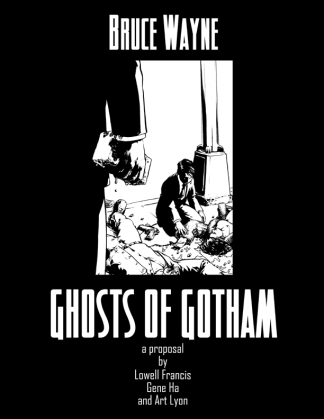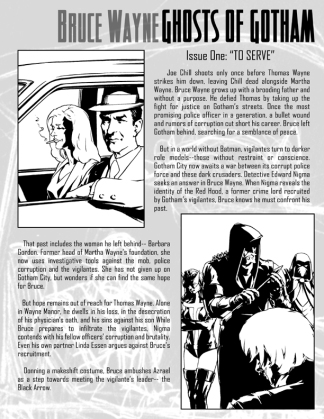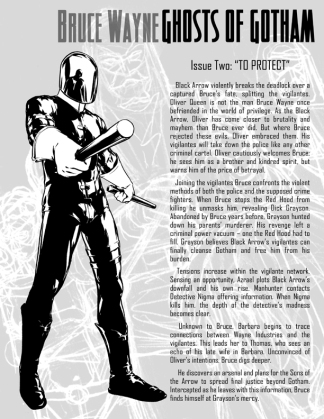BRUCE WAYNE: GHOSTS OF GOTHAM
I’ve known Gene Ha and Lowell Francis for…well, let’s just say “a long time” and move on, before my lumbago starts acting up. There was a stretch of a few years during which the three of us worked together developing ideas into presentable comic book pitches. Many of these involved DC Comics characters, because we all grew up reading comics, Gene had good relations at DC, I had colored a bunch of Gene’s (and other people’s) work there, and Lowell had a lot of storytelling and editing cred. (Eventually we all worked together on Project Superman, but that’s a story for another day.)
There were two ideas that reached a full pitch level, complete with conceptual art by Gene. Lowell posted about Riddles: Edward Nigma, Consulting Detective (with comments and some of the illustrations) on his excellent gaming blog, Age of Ravens. Riddles had a small cast of weird characters, and each issue was going to be an homage and send-up of traditional detective and pop-culture tropes and settings. It would have been a wild ride! He also posted about the more recent, text-only pitch Lowell and I put together for a revival of Warlord for DC’s “New 52” relaunch. Those posts by Lowell and the news about Fox’s upcoming “Gotham” tv series got me thinking about one of our pitches that hasn’t seen the light of day…
Of all the ideas the three of us pursued in depth, Bruce Wayne: Ghosts of Gotham was by far my favorite. It would have been part of DC’s “Elseworlds” imprint, an alternate take on existing DC Comics characters, their connections, situations, histories, motivations, modi operandi, etc. I kind of fell in love it, I think because of the fun and challenge of working out all those differences and new connection, because it was our own little version of the DC universe, and because of the chance to make more interesting a some characters who I normally don’t have much affinity for.
Initially it was a broad, sweeping thing that included characters from across the DC universe, including Superman, Lex Luthor, the Legion of Doom, and many more. There was a whole alternate Teen Titans idea in there somewhere. Because of the scale it started feeling a bit like Mark Waid and Alex Ross’ DC mini-series Kingdom Come.
Eventually we wisely narrowed the focus to Batman’s usual stomping grounds, Gotham City, perhaps with the thought that we could explore the larger-scale ideas and implications in theoretical sequels. Once we made that decision, the story really started to gel. Lowell still loves our treatment of Edward Nigma (traditionally the real name of the classic Batman villain, The Riddler). Once we started calling Green Arrow “Black Arrow”, I immediately thought of Robert Louis Stevenson’s The Black Arrow: A Tale of the Two Roses (a personal favorite of mine), and wanted to have his background and story arc mirror some of things in that novel.
The basic premise of Ghosts of Gotham involved the ripple effects of one simple change to a seminal event in Bruce Wayne’s childhood:
Instead of the classic moment in Batman’s “origin story” when a random thug with a gun senselessly murders Bruce’s parents before his eyes – setting Bruce on a disciplined path of revenge, justice, and a war on crime – in “Ghosts of Gotham” Bruce’s mother alone was shot and killed, and his father proceeds to beat the thug to death with a brick – as Bruce watches on in horror.
But I should let the pitch speak for itself. These are the actual full pages of the proposal we presented, so you’re seeing what the folks at DC saw. Text by Lowell, art by Gene, layout by me. I have no idea how I would have colored this comic at the time, had it come to that. Looking at it now, I would approach it very, very simply, since Gene was using a lot of blacks. The background images behind the text are taken from Gene’s rough sketches.
Click on the thumbnails below for bigger, readable versions.
Sadly, aside from any story problems that might exist, there were two sort of editorial problems that kept this idea from going to any next stage:
1. Apparently, in an Elseworlds story about Bruce Wayne, by the end of the story someone has to put on a Bat-costume of some kind. It’s a rule or something. I think we just didn’t want to force the whole bat-thing, and kind of wanted to explore a Gotham that didn’t have that. Oddly enough, our original, larger-scale idea would have not been so focused on Bruce Wayne and would have gotten around that.
2. By the time we presented the idea, DC was kind of done doing Elseworlds stories, but hadn’t made a point of it publicly. They were trying to refocus their brand, which eventually led to The New 52 version of the DC universe.
So, there you have it. I still have the crazy dream of using this idea – or something stemming from the same altered turning-point – as the setting for a role-playing game with friends some day.





















































